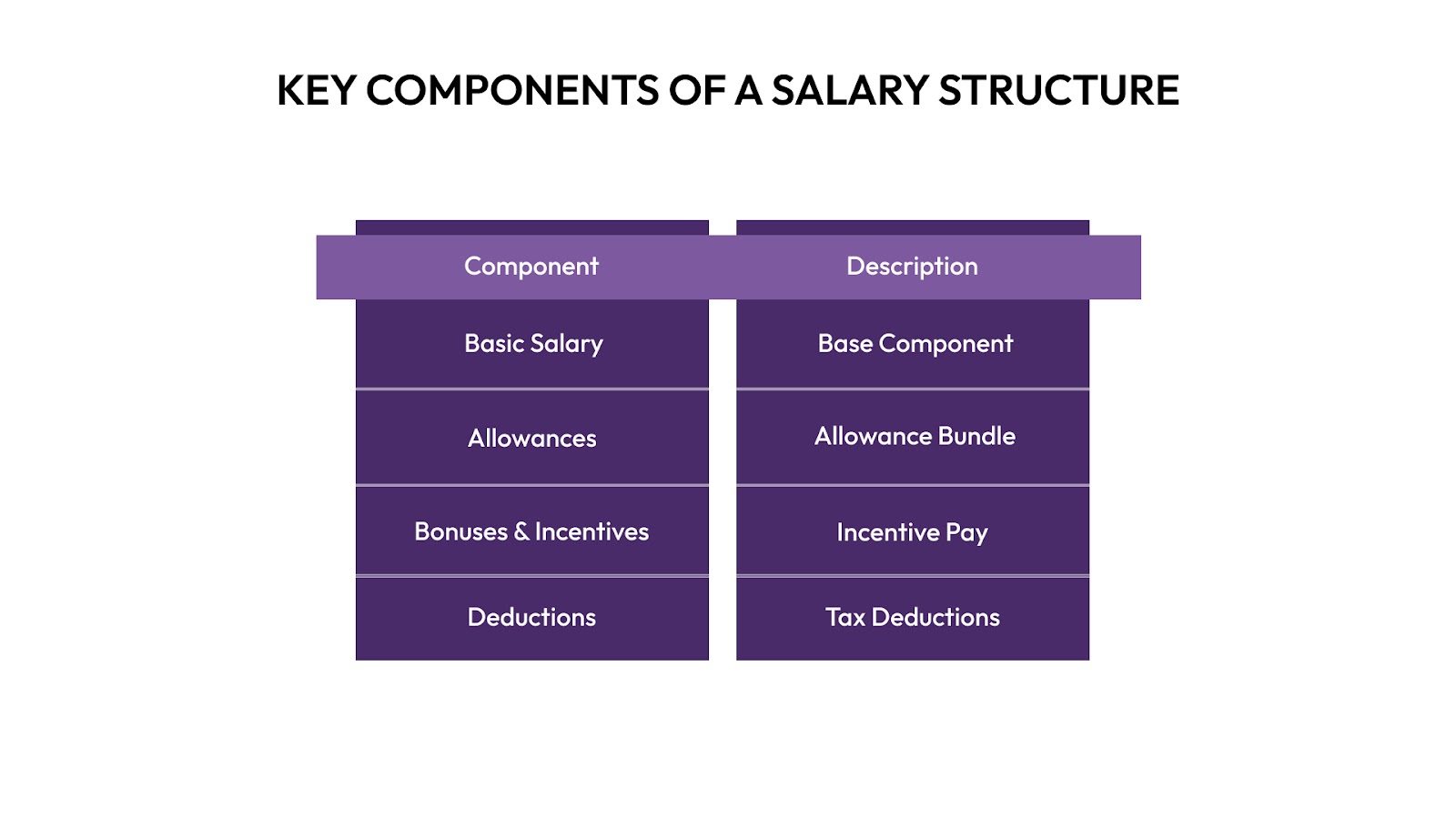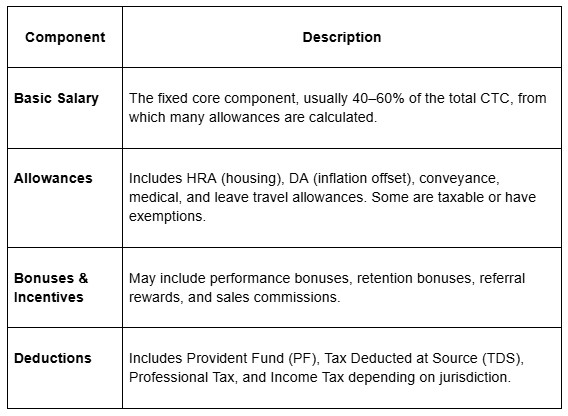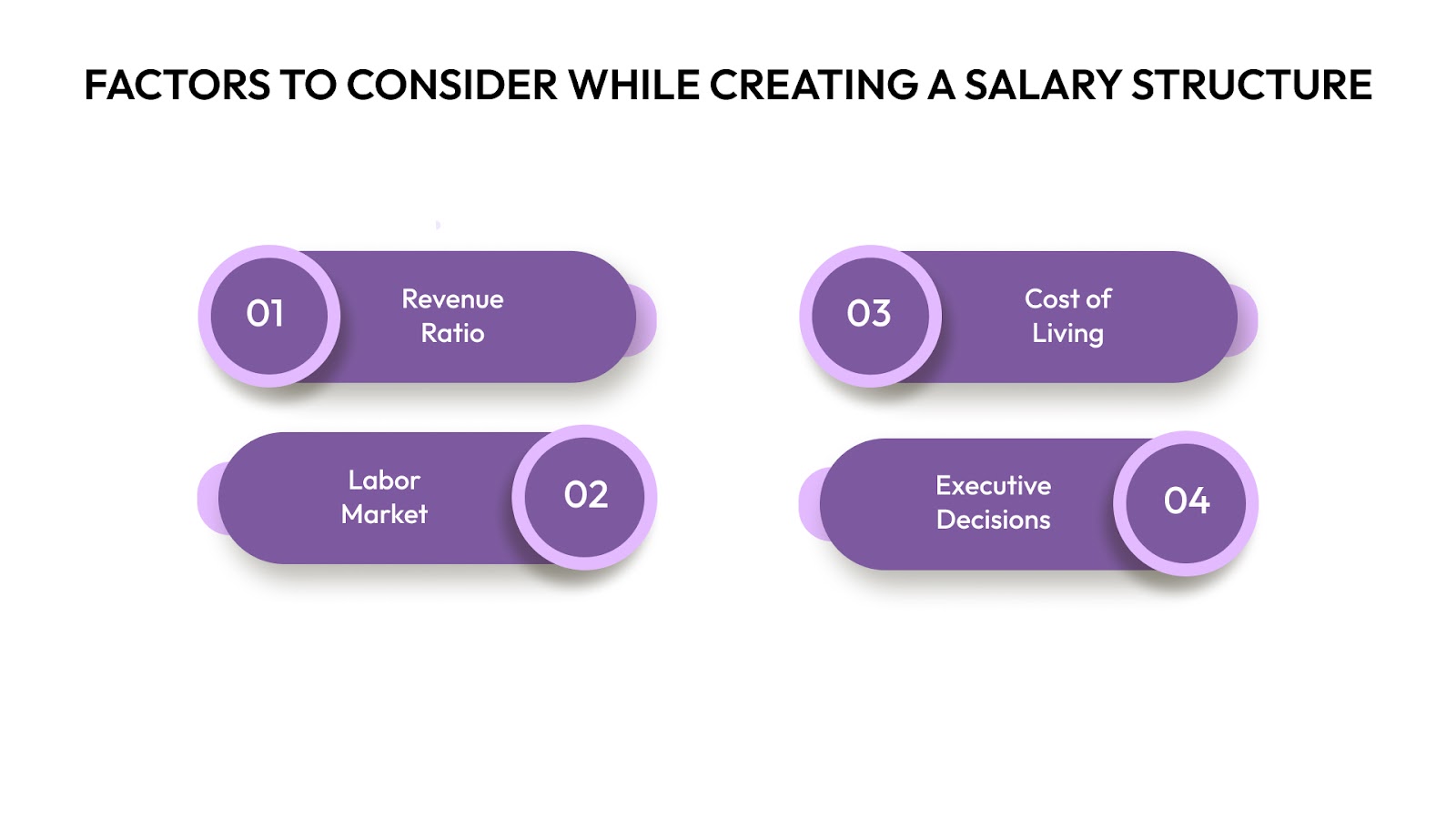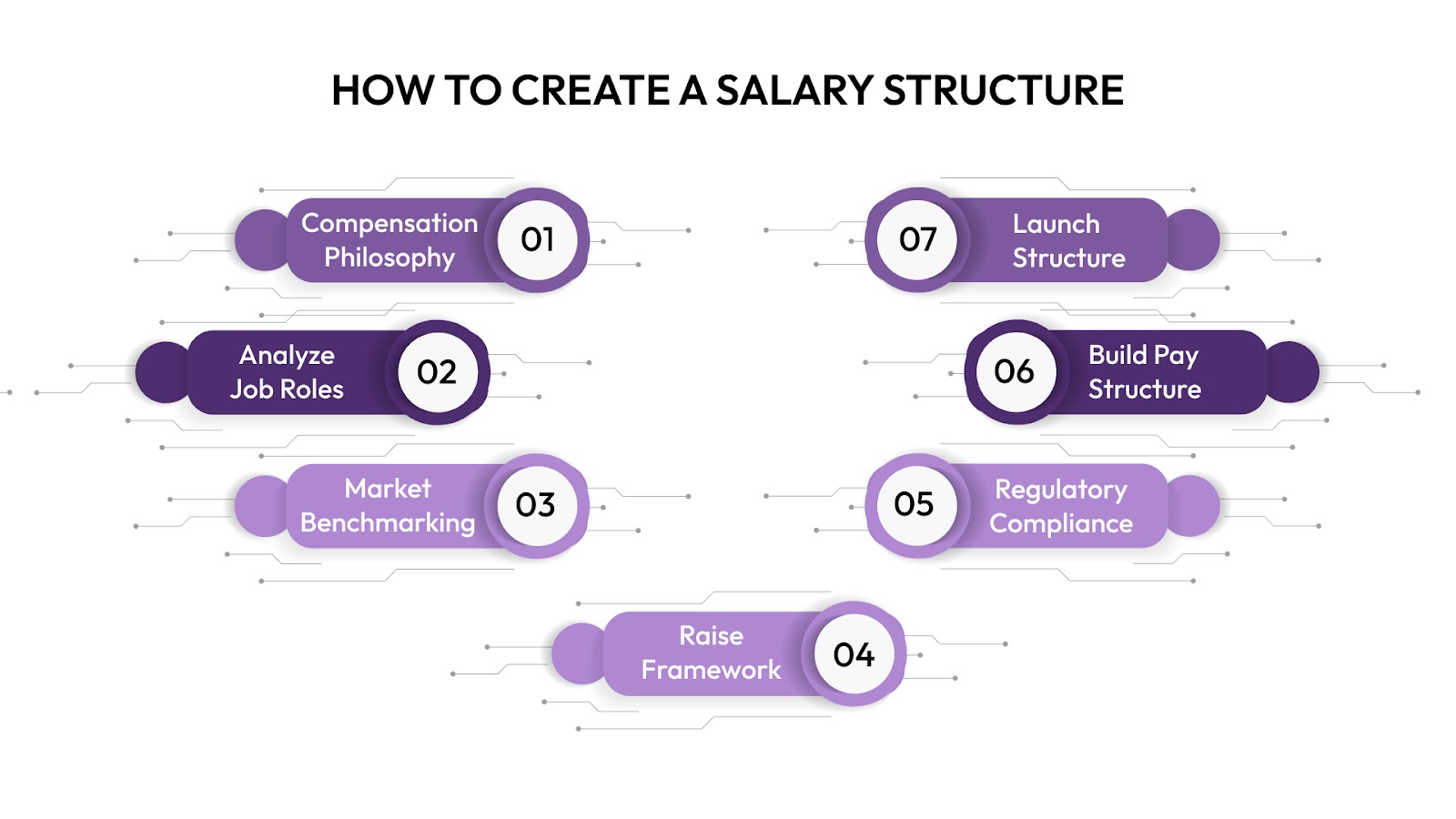How to Build a Scalable Salary and Raise Structure for Growing Organizations?
Design an effective raise structure by understanding pay raise percentages, integrating bonuses, preventing pay discrepancies, and ensuring transparency. Click to enhance your compensation strategy now.

Salary and raise structures are more than operational necessities, they are strategic tools for organizational alignment, retention, and financial control.
Designing a structured compensation framework for growth-stage and mid-sized companies, especially those operating with lean HR and finance teams, is critical to attracting top talent, promoting internal equity, and ensuring scalable workforce planning.
This blog outlines a structured approach to building and managing salary and raise frameworks. It covers core components, external and internal considerations, and actionable steps to create competitive and financially sustainable systems.
What is Salary Structure?
A salary structure is a formalized framework organizations use to define how employees are compensated across different roles, levels, and geographies. It outlines pay ranges, bonus eligibility, and allowance components based on job responsibilities, market benchmarks, location, skills, and experience.
A well-built salary structure brings clarity, consistency, and fairness to compensation practices rather than relying on ad hoc decisions or manager discretion. It is a critical foundation for HR, Finance, and leadership teams. Let’s learn the core components of an employee’s total compensation package to understand better how salary structures function.
Key Components of a Salary Structure

A salary structure often includes the following components, forming an employee’s total compensation or cost to company (CTC).

Understanding these components is just the first step, recognizing how a salary raise structure brings value to an organization is the next step.
Why Salary Structure Matters for Organizations?

Establishing a well-defined salary and raise structure is foundational to strategic HR and financial planning. For growth-stage and mid-sized organizations, especially those operating with lean HR teams, it helps create consistency, improve transparency, and align compensation decisions with business goals.
Below are the core reasons why an effective salary structure is essential.
Attracts High-Quality Talent
A structured and transparent salary framework enables companies to offer competitive, data-driven compensation aligned with industry standards. It signals professionalism and fairness to prospective candidates, making the organization more attractive to top-tier talent.
Internally, it supports employee retention by ensuring team members feel valued and compensated equitably, reducing the risk of attrition caused by pay dissatisfaction or perceived unfairness.
Enhances Motivation
Employees are more engaged and motivated when they understand how their efforts can lead to financial growth. A clear salary structure outlines how individuals can progress and what roles, skills, or achievements will lead to higher compensation. This transparency encourages goal-oriented performance and drives productivity across the organization.
Promotes Internal Equity and Transparency
Salary structures help eliminate pay discrepancies caused by inconsistent negotiation practices or unconscious bias. They ensure that employees with similar roles, qualifications, and experience receive comparable compensation, regardless of gender, location, or tenure.
Supports Financial Planning
A defined compensation framework gives Finance and HR teams a predictable and manageable view of payroll expenses. It makes forecasting future compensation costs easier, managing headcount growth, and analyzing the financial impact of hiring or promotion scenarios. This level of control is especially important for CFOs and FP&A leaders working to stay within budget while scaling the organization.
Simplifies Compensation Decision-Making
By standardizing how salaries and raises are determined, organizations reduce subjective or ad hoc compensation decisions. It creates alignment between managers, HR, and leadership, especially during hiring, promotion cycles, and performance reviews. This consistency saves time, minimizes disputes, and increases organizational efficiency.
Aligns Workforce Planning
Salary structures are a shared foundation for HR and Finance collaboration. Both teams operate from the same set of compensation parameters, adjusted for location, role, and seniority, ensuring more accurate modeling of hiring plans, cash burn, and budget utilization. This alignment enables better strategic decisions and proactive workforce planning.
Scales with Organizational Growth
As businesses grow, compensation complexity increases, with more roles, geographies, equity plans, and organizational layers. A structured salary framework provides a scalable solution that evolves with the company. It ensures that compensation remains consistent and aligned, even as headcount grows 2–3x annually.
A well-defined salary structure drives retention, fairness, and financial clarity across teams. It streamlines decision-making and supports long-term growth. However, designing an effective structure requires careful consideration.
Factors to Consider While Creating a Salary Structure

When building a salary structure, multiple internal and external influences impact compensation strategy when building a salary structure. These factors ensure the structure remains financially viable, competitive in the market, and aligned with organizational goals. Below are key considerations every company should evaluate before finalizing its salary framework.
Revenue vs. Salary Expenditure
A company must assess its financial stability and cash flow before defining salary structures. If employee salaries are to be paid from incoming revenue, businesses must factor in the payment collection cycle, such as delays between invoicing and actual receipt.
A mismatch between salary commitments and revenue inflows can cause operational strain, making it crucial to align pay cycles with cash availability. This balance ensures both timely payments and financial sustainability.
Labor Market Conditions
Local and industry-specific labor market trends significantly influence salary design. When the demand for specific skill sets is high but qualified talent is scarce, companies must offer more attractive salaries to remain competitive. Understanding whether you operate in a talent-rich or talent-scarce environment helps adjust compensation to attract the right candidates.
Cost of Living Variations
Geographical differences play a significant role in salary decisions. In cities where housing, transportation, and daily expenses are high, companies must offer higher salaries to ensure employees maintain a reasonable standard of living. Compensation should be adjusted accordingly for in-office roles based in expensive urban areas, while remote roles can be more cost-efficient if filled by employees in lower-cost regions.
Administrative and Executive Decisions
Leadership teams have a central role in shaping salary structures. Their perception of a role’s value to the business, risk tolerance, and vision for growth all influence pay levels. From setting compensation philosophies to approving salary bands and growth margins, administrative attitudes impact how aggressive, conservative, or flexible a company is with its pay practices.
With these critical factors in mind, companies can confidently design a salary structure that is both strategic and sustainable. Let’s discuss how to begin building one that fits your organization’s unique goals and workforce needs.
How to Create a Salary Structure?

Designing a salary structure doesn’t have to be overwhelming. When done right, it becomes a solid foundation for attracting top talent, retaining high performers, and ensuring long-term organizational health. Below are the key steps to building a salary structure that aligns with your company’s values, financial goals, and hiring needs.
1. Define Your Compensation Philosophy
Begin by establishing your organization’s overall approach to compensation. This includes deciding whether your company wants to offer salaries that lead, match, or fall slightly below the market average.
Your philosophy should reflect what your business can afford, what your industry demands, and what values you want to reinforce, such as rewarding high performance, offering long-term stability, or supporting work-life balance. A well-articulated compensation philosophy provides a clear framework for consistent decision-making.
2. Analyze and Benchmark Job Roles
Evaluate each job role based on responsibilities, required skills, and expected contributions. Identify what qualifications, experience, and certifications are necessary for each role.
Understanding the scope and complexity of a job helps you assign it to an appropriate level or pay grade. This internal assessment ensures internal equity and lays the groundwork for effectively mapping roles to salary bands.
3. Conduct Market Benchmarking
Research industry standards and salary data to determine what other companies pay for similar roles in your sector and region. Market benchmarking helps you position your salary ranges competitively, so you can attract and retain the right talent. Use trusted salary surveys, compensation platforms, or industry reports to ensure your data is accurate and relevant.
4. Determine Raise Guidelines and Progression Paths
Establish how employees will progress in their pay over time, whether through performance reviews, promotions, skill development, or tenure. Define the average percentage range for raises and how frequently they will be reviewed. This ensures predictability for the organization and employees, supports retention, and helps forecast future compensation budgets.
5. Ensure Legal and Regulatory Compliance
Check your salary structure against local and national labor laws to ensure compliance. This includes adhering to minimum wage laws, statutory bonus and gratuity rules, and mandatory employer contributions such as Provident Fund or social security. Legal compliance protects your organization from penalties and builds employee trust in the fairness of your compensation practices.
6. Design the Salary Structure and Components
Use all the information gathered to construct structured pay bands for each role or job level. Include key components such as basic salary, allowances (HRA, DA, medical, travel), variable pay (bonuses, incentives), and benefits (insurance, retirement contributions). Your structure should balance fixed and flexible components to align with your compensation philosophy and financial resources.
7. Communicate and Implement the Structure
Once the structure is finalized, ensure it is documented and shared with relevant teams such as HR, finance, and hiring managers. Provide training or guidelines on how to apply the structure consistently during hiring and performance appraisals. Communicate transparently with employees about how their salaries are determined and how they can progress within the system. A well-implemented structure fosters trust, reduces confusion, and enhances employee engagement.
Once your salary structure is in place, the next challenge is managing it effectively at scale. Tools like CandorIQ help you manage and evolve your compensation strategy.
How CandorIQ Enhances Raise and Salary Structures?
Building an effective salary and raise structure is key to driving employee satisfaction, business performance, and sustainable growth. CandorIQ simplifies this process with tools that help companies create compensation frameworks that are fair, transparent, and aligned with strategic goals.
Here’s how CandorIQ supports every step.
- Retention of Top Talent: CandorIQ connects compensation directly to performance, helping companies recognize and reward high-impact employees. This alignment reinforces employee value and is crucial in retaining top performers in competitive markets.
- Budget Efficiency: With intelligent compensation modeling and budgeting tools, CandorIQ equips HR and finance leaders to allocate raise budgets with precision. This ensures salary increases are impactful while maintaining overall financial discipline.
- Pay Transparency: CandorIQ makes designing and implementing transparent raise structures easier. By reducing subjectivity and bias, the platform supports equitable pay practices, strengthens trust within the workforce, and fosters a culture of fairness.
- Performance Motivation: Raises tied to clear performance metrics encourage employees to align their efforts with company goals. CandorIQ brings visibility and consistency to this process, making it easier for employees to understand how their performance influences compensation.
- Scalability: As companies grow and expand into new teams, departments, or geographies, CandorIQ ensures compensation structures scale seamlessly. Standardized processes allow for consistency across the organization while remaining flexible for local context.
With products like the Compensation & Payband Builder and Compensation Cycle Management, CandorIQ gives organizations the confidence to design, manage, and automate raise structures. The result is a compensation system that’s fair, motivating, and built to grow with your business.
Conclusion
Designing a salary and raise structure is more than a compliance task—it’s a strategic investment in your people and your company’s future. A thoughtfully built framework drives talent acquisition, boosts retention, ensures internal equity, and empowers teams to perform at their best. It also sets a strong foundation for financial planning and organizational scalability.
CandorIQ takes this to the next level by helping companies implement data-driven compensation strategies that are fair, transparent, and scalable. With tools like the Compensation & Payband Builder and Cycle Management, CandorIQ streamlines decision-making and enhances pay transparency, saving companies an average of $500K+ annually on headcount costs through smarter compensation planning.
Book your demo today and take control of your compensation strategy.


